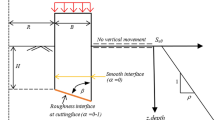Abstract
A genetic algorithm technique, integrated with a numerical model (finite element method), was used in this study to compute the optimal cut-off location and angle of inclination for barrages constructed on homogenous anisotropic soil foundations. The exit gradient function is minimized as an objective function in the problem formulation. Constraints included uplift pressure functions and safety factors taking account of a minimum concrete floor thickness. Various degrees of anisotropy and different values of a range of heads have been studied. Around 1400 different situations (cases) were simulated using SEEP2D GMS software. Statistical nonlinear regression models were used to predict the pressure head and exit gradient for anisotropic soil foundations under various degrees of inclination (θ), relative location (b1/b) and relative depth (d/b). A genetic algorithm optimization model was also performed using Matlab. The study results indicated that the computed optimum cut-off locations and relative inclination angles were affected by changing the anisotropic ratio and relative cut-off depth. For isotropic soil foundations, for cases with a cut-off ratio (d/b) of up to 0.4, the optimum inclination angle ranged between 59° and 68° for upstream locations. In other relative cut-off depth cases, the cut-off can work efficiently when situated in the last third of the concrete floor foundation, this considered the optimum location. For anisotropic soil, optimum locations tended to be upstream for most d/b values.









Similar content being viewed by others
References
Abbas ZI (1994) Conformal analysis of seepage below a hydraulic structure with an inclined cutoff. Int J Numer Anal Methods Geomech 18:345–353
Abdoul Hadi AAA, Shukur AH, Al-Musawi WH (2006) Optimum design of control devices for safe seepage under hydraulic structures. J Eng Dev 10(1):66–87
Al-Senousi KF, Mohamed HG (2008) Effect of inclined cut-off and soil foundation characteristics on seepage beneath hydraulic structures. In: 10th international water technology conference, IWTC12, Alexandria
Al-Suhaili RH, Karim RA (2014) Optimal dimensions of small hydraulic structure cutoffs using coupled genetic algorithm and ANN model. J Eng 20(2):1–19
Esmat ZA (2011) The effect of cutoff wall angle on seepage under dams. J Eng 17(5):1109–1131
Garg NK, Bhagat SK, Asthana BN (2002) Optimal barrage design based on subsurface flow considerations. J Irrig Drain Eng 128(4):253–263
Garg NK, Chawre B, Singh A (2014) Design of barrage on heterogeneous and anisotropic soils. Curr Sci 107:1875–1879
Hassan WH (2017) Application of a genetic algorithm for the optimization of a cutoff wall under hydraulic structures. J Appl Water Eng Res 5(1):22–30
Mishra GC, Reddy AS (1983) Exit gradient in anisotropic porous medium. J Hydraul Eng 109(6):897–904
Mohamed HG, Agiralioglu N (2005) Effect of inclined cut-offs and foundation soil on seepage flow beneath a hydraulic structure. J Istanb Tech Univ Eng 4:82–92
Novak P, Moffat AIB, Nalluri C, Narayanan R (2007) Hydraulic structures, 4th edn. Taylor & Francis, London
Singh RM (2007) Optimal design of barrages using genetic algorithm. In: Proceedings of national conference on hydraulics and water resources (Hydro-2007) at SVNIT, Surat, pp 623–631
Singh RM (2011) Optimal hydraulic structures profiles under uncertain seepage head. World Renewable Energy Congress, Linköping
Author information
Authors and Affiliations
Corresponding author
Rights and permissions
About this article
Cite this article
Hassan, W.H. Application of a Genetic Algorithm for the Optimization of a Location and Inclination Angle of a Cut-Off Wall for Anisotropic Foundations Under Hydraulic Structures. Geotech Geol Eng 37, 883–895 (2019). https://doi.org/10.1007/s10706-018-0658-9
Received:
Accepted:
Published:
Issue Date:
DOI: https://doi.org/10.1007/s10706-018-0658-9




